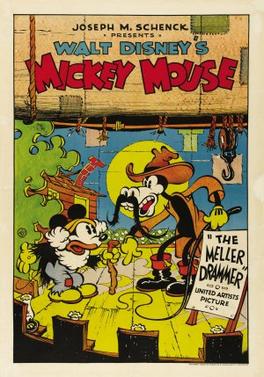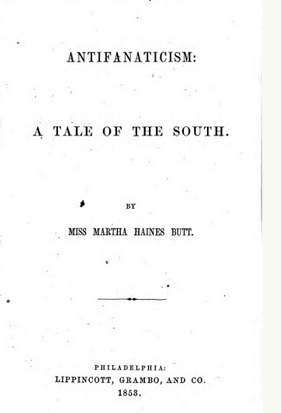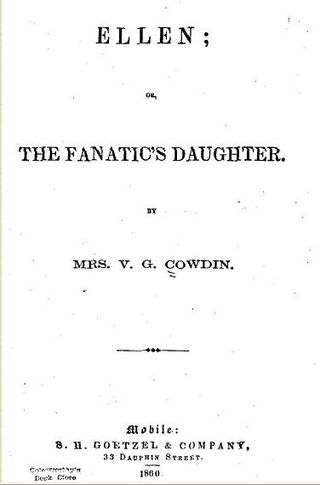
Uncle Tom's Cabin; or, Life Among the Lowly is an anti-slavery novel by American author Harriet Beecher Stowe. Published in two volumes in 1852, the novel had a profound effect on attitudes toward African Americans and slavery in the U.S., and is said to have "helped lay the groundwork for the [American] Civil War".

Dred: A Tale of the Great Dismal Swamp is the second popular novel from American author Harriet Beecher Stowe. It was first published in two volumes by Phillips, Sampson and Company in 1856. Although it enjoyed better initial sales than her previous, and more famous, novel Uncle Tom's Cabin, it was ultimately less popular. Dred was of a more documentary nature whereas Uncle Tom's Cabin had much stronger characters.

The Leopard's Spots: A Romance of the White Man's Burden—1865–1900 is the first novel of Thomas Dixon's Reconstruction trilogy, and was followed by The Clansman: A Historical Romance of the Ku Klux Klan (1905), and The Traitor: A Story of the Fall of the Invisible Empire (1907). In the novel, published in 1902, Dixon offers an account of Reconstruction in which he portrays a Reconstruction leader, Northern carpetbaggers, and emancipated slaves as the villains; Ku Klux Klan members are anti-heroes. While the playbills and program for The Birth of a Nation claimed The Leopard's Spots as a source in addition to The Clansman, recent scholars do not accept this.

Anti-Tom literature consists of the 19th century pro-slavery novels and other literary works written in response to Harriet Beecher Stowe's Uncle Tom's Cabin. Also called plantation literature, these writings were generally written by authors from the Southern United States. Books in the genre attempted to show that slavery was beneficial to African Americans and that the evils of slavery as depicted in Stowe's book were overblown and incorrect.

Aunt Phillis's Cabin; or, Southern Life as It Is by Mary Henderson Eastman is a plantation fiction novel, and is perhaps the most read anti-Tom novel in American literature. It was published by Lippincott, Grambo & Co. of Philadelphia in 1852 as a response to Harriet Beecher Stowe's Uncle Tom's Cabin, published earlier that year. The novel sold 20,000–30,000 copies, far fewer than Stowe's novel, but still a strong commercial success and bestseller. Based on her growing up in Warrenton, Virginia, of an elite planter family, Eastman portrays plantation owners and slaves as mutually respectful, kind, and happy beings.

The Planter's Northern Bride is an 1854 novel written by Caroline Lee Hentz, in response to the publication of Uncle Tom's Cabin by Harriet Beecher Stowe in 1852.

Mickey's Mellerdrammer is a 1933 American animated short film produced by Walt Disney Productions and released by United Artists. The title is a corruption of "melodrama", thought to harken back to the earliest minstrel shows, as a film short based on Harriet Beecher Stowe's 1852 anti-slavery novel Uncle Tom's Cabin and stars Mickey Mouse and his friends who stage their own production of the novel. It was the 54th Mickey Mouse short film, and the fourth of that year.
Uncle Robin, in His Cabin in Virginia, and Tom Without One in Boston is an 1853 novel written by J.W. Page and released by J. W. Randolph Publishers of Richmond, Virginia.

Antifanaticism: A Tale of the South is an 1853 plantation fiction novel by Martha Haines Butt.
White Acre vs. Black Acre is an 1856 plantation fiction novel written by William M. Burwell.
Life at the South; or, "Uncle Tom's Cabin" As It Is is an 1852 plantation fiction novel written by William L.G. Smith.
The North and the South; or, Slavery and Its Contrasts is an 1852 plantation fiction novel by Caroline Rush, and among the first examples of the genre, alongside others such as Aunt Phillis's Cabin by Mary Henderson Eastman and Life at the South; or, "Uncle Tom's Cabin" As It Is by W.L.G. Smith, both of which were also released in 1852.
Frank Freeman's Barber Shop is an 1852 plantation fiction novel written by Baynard Rush Hall.
The Lofty and the Lowly, or Good in All and None All Good is a novel by Maria Jane McIntosh published by D. Appleton & Company in 1853. It was one of many anti-Tom novels published in response to Harriet Beecher Stowe's Uncle Tom's Cabin. The story is set is Georgia and tells of a plantation owner's efforts to avoid bankruptcy with the help of his loyal slave Daddy Cato. Their efforts are challenged by a northern usurer and devious northern capitalists. The book sold well across the United States upon release, making it one of the most successful anti-Tom novels in the middle 19th century.

Mr. Frank, the Underground Mail-Agent is an 1853 parody novel written by an unknown author credited as "Vidi".
Liberia; or, Mr. Peyton's Experiments is an 1853 novel by Sarah Josepha Hale, the author of the nursery rhyme "Mary Had a Little Lamb", who wrote the novel under the name of Sara J. Hale.

Ellen; or, The Fanatic's Daughter is an 1860 plantation fiction novel written by Mrs. V.G. Cowdin.

The Life of Josiah Henson, Formerly a Slave, Now an Inhabitant of Canada, as Narrated by Himself is a slave narrative written by Josiah Henson, who would later become famous for being the basis of the title character from Harriet Beecher Stowe's 1852 novel Uncle Tom's Cabin. The Life of Josiah Henson, published in 1849, is Henson's first work but was dictated to Samuel A. Eliot, who was a former Boston Mayor known for his anti-slavery views. Although Henson was an accomplished orator, he had not yet learned to read and write. The narrative provides a detailed description of his life as a slave in the south.
The Ebony Idol is a plantation literature novel by G. M. Flanders, first published in 1860. It is one of several pro-slavery novels written in the Southern United States in response to the 1852 abolitionist novel Uncle Tom's Cabin by Harriet Beecher Stowe.
Charles Jacobs Peterson was an American author and publisher.










